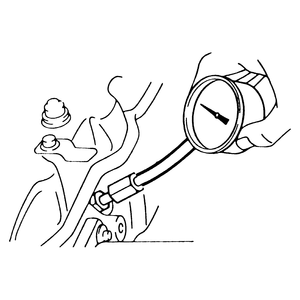A noticeable lack of engine power, excessive oil consumption and/or poor fuel
mileage measured over an extended period are all indicators of internal engine
wear. Worn piston rings, scored or worn cylinder bores, blown head gaskets,
sticking or burnt valves and worn valve seats are all possible culprits here.
A check of each cylinder's compression will help you locate the problems.
As mentioned in the Tools and Equipment section of Section 1, a screw-in type
compression gauge is more accurate than the type you simply hold against the
spark plug hole. Although the screw-in type takes slightly longer to use, it's
worth it to obtain a more accurate reading.
- Before checking the engine compression, make sure that the battery is fully
charged.
- Warm up the engine to its normal operating temperature.
- Shut off the engine, then remove all spark plugs.
- Disconnect the high tension lead from the ignition coil.
- Fully open the throttle either by operating the carburetor throttle linkage
by hand, or by having an assistant floor the accelerator pedal.
| Fig. 1: A screw-in type compression gauge is preferable

|
- Screw the compression gauge into the No. 1 spark plug hole until the fitting
is snug.
NOTE: Be careful not to crossthread the plug hole. Use
extra care on aluminum cylinder heads, as the threads in these heads are
easily ruined.
- Ask an assistant to depress and hold the accelerator pedal fully (on both
carbureted and fuel injected vehicles). Then, while you read the compression
gauge, ask the assistant to crank the engine two or three times in short bursts
using the ignition switch.
- Read the compression gauge at the end of each series of cranks, and record
the highest of these readings. Repeat this procedure for each of the engine's
cylinders. Compare the highest reading of each cylinder to the readings of
the other cylinders. The readings should be similar throughout the engine.
NOTE: A cylinder's compression pressure is usually acceptable
if it is not less than 80% of the highest reading. For example, if the highest
reading is 150 psi, the lowest should be no lower than 120 psi. Also, no
cylinder should be less than 100 psi.
- If a cylinder is unusually low, pour a tablespoon of clean engine oil into
the cylinder through the spark plug hole and repeat the compression test.
If the compression comes up after adding the oil, it appears that the cylinder's
piston rings or bore are damaged or worn. If the pressure remains low, the
valves may not be seating properly (a valve job is needed), or the head gasket
may be blown near that cylinder. If compression in any two adjacent cylinders
is low, and if the addition of oil doesn't help the compression, there is
probably leakage past the head gasket. Oil and coolant water in the combustion
chamber can result from this problem. There may be evidence of water droplets
on the engine dipstick when a head gasket has blown.



